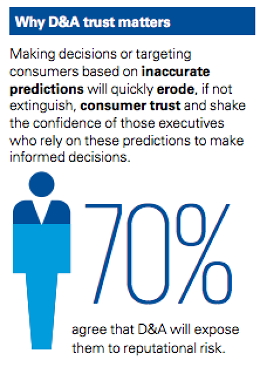Why Executives Don’t Trust Their Own Data And Analytics Insights
Organizations of all shapes and sizes are investing heavily in data and analytics, yet few trust the resulting findings.
A CapGemini and EMC study of 1,000 senior executives and decision makers across nine industries and 10 countries found that over half (56%) plan to increase their investment in big data analytics over the next three years. Part of the premium they are paying to gather, maintain, and analyze data is going toward hiring expert staff. Data scientists are the most in-demand and highest paid engineering and IT employees in America right now.
Yet, according to a recent survey of over 2,000 data and analytics (D&A) decision makers in 10 countries by KPMG and Forrester Consulting, only 38% of respondents have a high level of confidence in their customer insights, and only one third trust the analytics they generate from their business operations.
In spite of a self-reported lack of trust in their own information, a majority of respondents say these insights are vital to business decision-making. Half of those surveyed reported using data and analytics tools to analyze existing customers, 48% reported using them to find new customers, and another 47% use them to develop new products and services.

“As analytics increasingly drive the decisions that affect us as individuals, as businesses, and as societies, there must be a heightened focus on ensuring the highest level of trust in the data, the analytics, and the controls that generate desired outcomes,” said Christian Rast, the global head of data and analytics and a partner with KPMG in Germany, in a statement. “Organizations that continue to invest in D&A without determining its effectiveness could likely make decisions based on inaccurate models, which would perpetuate a cycle of mistrust in the insights.”
It’s Complicated
Nearly half of C-level respondents indicate that they don’t support their organization’s D&A strategy, according to the report. Bill Nowacki, the managing director of decision science at KPMG in the U.S. suggests this may be due to a clash between old-school instincts, which guided executives previously, and new technology.
“There is no doubt that subjective, gut-feel decision-making is being augmented by data-driven insights to allow organizations to better serve customers, drive efficiencies and manage risk,” he said in a statement. “The survey, however, indicates executives’ level of confidence in their insights is not where it should be, given these organizations’ plans for increasing investment in and returns on D&A.”

Another reason for this overall lack of trust in insights generated through D&A could be a result of sheer complexity, suggested Brad Fisher, the U.S. D&A leader, and a partner with KPMG U.S. “Transparency about the use and impact of an organization’s data and analytics is key to overcoming the long-held bias that conventional decision making is more reliable,” he said in a statement.
When there’s a lot of information to parse, the mind gets overloaded and tends to revert to the brain’s “somatic markers” which signal whether something feels right, or doesn’t. Scientific research has proven that such intuition is more reliable when it comes to making a decision than relying on fact alone.
To combat this, Fisher recommends providing executives with more transparency and explanation around how insights are gathered so that they can better trust the information that results.
Rast suggests a seven-step approach to help D&A professionals gain the trust of their executives.
- Assess the trust gaps
- Create purpose by clarifying goals
- Raise awareness to increase internal engagement
- Develop an internal D&A culture
- Open up the “black box” to encourage greater transparency
- Have a 360-degree view by building ecosystems
- Stimulate innovation and analytics R&D to incubate new ideas and maintain a competitive stance.
“It’s imperative that D&A leaders make trust a high priority,” adds Rast. “To be a competitive, D&A-driven organization, business leaders must navigate the complex processes, systems, compliance requirements, and governance to confidently and consistently move from insights to measurable action.”
Fast Company , Read Full Story
(48)














